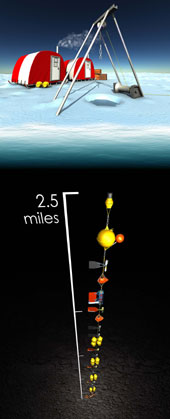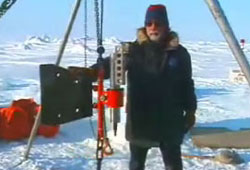 |
|
|
 |
||
|
||||||||||
|
NSF'S North Pole Researchers Study Climate Change in the Arctic
Video/Animation Available: Graphics editors: Long before a Hollywood blockbuster about catastrophic climate change packed cinema multiplexes this spring, researchers at the top of the world, supported by the National Science Foundation (NSF), were using an array of scientific tools to build a comprehensive scientific picture of environmental change in the Arctic and what it may mean for the rest of the globe. Led by oceanographer James Morison, of the University of Washington, NSF- supported scientists from Oregon State University, as well as others supported by the National Oceanic and Atmospheric Administration (NOAA), the Naval Post-graduate School, and the Japan Marine Science and Technology Center, are conducting an array of experiments at the North Pole to understand this little-known, but extremely important region. The Polar regions, scientists believe, will sound the earliest warnings that changes in global climate are underway and, in recent years, the Arctic has experienced a well-documented warming trend. Whether this change is permanent or part of a cycle and what the potential effects of a warmer Arctic Ocean could be are questions the team hopes to answer. NSF, which funds the North Pole Environmental Observatory (NPEO) through its Office of Polar Programs, is making available video of the researchers working at the Pole, interviews with key NPEO scientists at the Pole and an animation of a mooring string scientists use to place instruments there. The mooring collects and measures ice thickness and movement, water temperature and salinity, and the speed and direction of underwater polar currents for a year. In keeping with the global scale of the project, the mooring string stretches more than 4.2 kilometers (2.6 miles) from the bottom of the Arctic Ocean to within feet of the constantly shifting polar ice pack. That's longer than Mt. Rainier is high. In addition to the mooring, scientists with Morison's group are drilling through ice often more than 3.6 meters (12 feet) thick to install NOAA buoys that measure air temperatures through the ice cover. They also are imbedding automated sensors into the sea ice to send the detectors on a trek thousands of meters long, from the North Pole to Greenland, to measure heat fluctuations in the upper ocean. Subtle changes in these temperatures can mean large variations in the thickness of ice that covers the ocean. Finally, Morison and colleague Kelly Falkner, of Oregon State University, fly a small aircraft along a line several thousand kilometers long from which they take seawater samples from 1,000 meters below the surface for chemical analysis. HOW TO RECEIVE C-BAND FEED: Thursday, June 17, 2:15 – 2:30 p.m. ET IA 6, Tr. 15, DL 4000 Technical Info DURING FEED ONLY, NBN, TOC, (212) 684–8910 x 221 VIA PATHFIRE - FREE FROM NEWS BROADCAST NETWORK, (212) 684- 8910
The National Science Foundation (NSF) is an independent federal agency that supports fundamental research and education across all fields of science and engineering, with an annual budget of nearly $5.58 billion. NSF funds reach all 50 states through grants to nearly 2,000 universities and institutions. Each year, NSF receives about 40,000 competitive requests for funding, and makes about 11,000 new funding awards. The NSF also awards over $200 million in professional and service contracts yearly. Receive official NSF news electronically through the e-mail delivery system, NSFnews. To subscribe, send an e-mail message to join-nsfnews@lists.nsf.gov. In the body of the message, type "subscribe nsfnews" and then type your name. (Ex.: "subscribe nsfnews John Smith") Useful NSF Web Sites:
|
||||||||||
|
|
|
|


